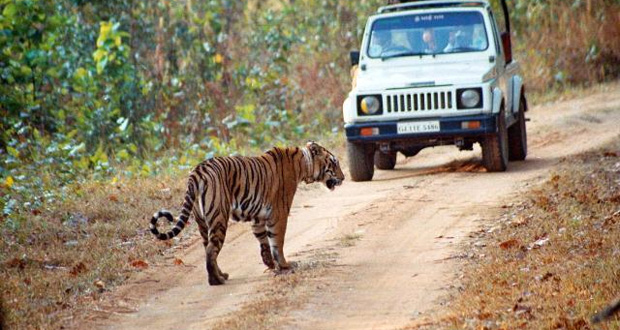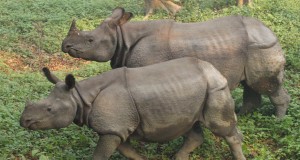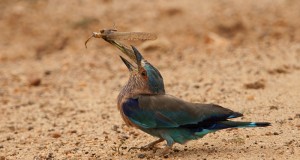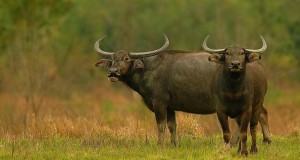Manias : -[his sanctuary, in contrast to Kaziranga, is far removed from the National Highway and the mainstream of human life passes it by. Barpeta Road, the railhead which also serves as the sanctuary’s headquarters, is almost three hours by road or rail from Guwahati.
Manas has a much longer season than Kaziranga, the only wet period being from mid-May to September, but the best period to visit the area is either in November or February. Unlike the open swamps and grasslands of Kazirariga , where the visitor may see a large number of animals, wildlife viewing in Manas is never regular—or easy. But when one is confronted by an animal, it is usually at close quarters and, invariably, exciting and dramatic.
Few places can hold a visitor in its grip the way Manas can. Over 1000 sq miles (2600 sq km) in area, the Manas river at Mothanguri forms the boundary between India and Bhutan, and one of the great attractions of the park is the golden langur which inhabit the tall flowering trees next to the Royal Hunting Lodge where the King of Bhutan retreats once a year or so. The topography of the reserve is dramatically diverse; the river spilling out of the foothills; the lower sandy stretches where islands of trees stand like sentinels over herds of wild buffalo, with fishing eagles and ospreys searching the fast flowing streams for fish. There are the great forests of mixed deciduous vegetation which shut the light off at ground level, and finally small glades of grassland where elephant herds leave their calling card by uprooting every invading sapling that tries to encroach into the glades.
In terms of diversity in animal life, Manas again stands alone. There are twenty species of birds and animals here which are listed under Schedule I (highly endangered) in the IUCN Red Data Book, and of these species, some like the hispid hare and the pigmy hog are today found only here. Both these remarkable animals have been reduced to a rarity, so much so that their extinction was once thought to be just a matter of time. The situation today is less desperate.
As one drives into Manas from Barpeta Road, leaving the long semul-lincd drive and the Bansbari tea estate behind, the gravel road snakes through open grassland which is said to be prime country for the hispid hare, which is also known as the Assamese rabbit. During late evenings, just as dusk gives way to darkness, the beam from a vehicle’s headlights sometimes spotlights the scurrying figure of this elusive and rare animal.
Mothanguri is the ideal, and perhaps the only place to stay in. Situated on a rise overlooking the Manas river, there could be few places so endearing to a naturalist. From the balcony of the rest house, one overlooks Bhutan while on the Indian side the forests are tinged with pink, especially in February when the semul trees are explosions of color. The Project Tiger people have a number of riding elephants which provide the ideal means to move about and give the visitor the best approach to wildlife, but the saddles or howdahs are quite different from the broad seats of North and South India. Here, one needs to straddle the animal or sit sideways on the saddle, a painful exercise at the best of times. Red ants, notorious for a rather painful sting, also seem to have been designed by nature to drop onto you from their leaf nests in trees, and there is little one can do other than watch out for them.
While the golden langur are usually approachable on foot from the boat landing on the Bhutan side, the colorful capped langur is only approachable from elephant back. Extremely shy, these primates usually move away, but if one were to watch them quietly for half an hour, they seem to forget your presence and go about their business of eating and grooming with the nonchalance so typical of the langur family. The Assamese macaque is rarely seen in the forests, but they inhabit the islands downstream and move in large troupes from place to place. The slow loris and the Hoolock gibbon also extend into Manas, but sightings are rare.
Most of the animals found in Kaziranga are also found in Manas. Rhino is not as plentiful, but a reasonable population exists, but here these animals are extremely shy and make off at the slightest disturbance, using the heavy undergrowth to their advantage. Two of the main attractions, however, are the water buffalo and the elephant. The ideal way to observe buffalo is to hire a boat at Mothanguri and spend the better part of the day drifting downstream before being picked up by motorized transport some 22 miles (35 km) away. The herds come to the river during the day to cool off and they stare curiously at the drifting boat, their sweeping and majestic horns thrown back in graceful arcs. The lone bull, always game for a fight, will toss his head as only a bull can and sometimes he will follow along the side, presenting a sight which is rarely forgotten.
On elephant-back too, one sometimes succeeds in surprising a herd in the water, which then struggles to the bank through the mist and the water.
Locating elephants in the thick forest is never an easy task, but once a herd is found the riding elephant often manages to get into the herd. To be surrounded by a herd of trumpeting wild elephants can leave one weak around the knees, and to be charged by a lone bull is by no means an uncommon occurrence here. Fortunately, the trained elephants are adept at making a quick getaway, but the image of a charging tusker with its ears fanned out is a memory that can never fade.
A lot more elusive and shy is the Indian bison, or gaur, which stands taller than a buffalo at the shoulder. Sometimes, one can see a large herd in the grassy glades, but at the slightest sound or movement, they thunder off into the cover of the forest. Another method of looking for gaur is to drive along the foothills, on jungle tracks which are hemmed in by tall grass on either side. The area is full of hog deer and sometimes a tiger can be seen plodding along the tracks, looking for a chance to kill. This stretch is good for the other big cats too. When fires are lit to burn the grass, a clouded leopard may emerge from behind a smoldering tree trunk where he had been feeding off insects which are forced out by the smoke. Manas provides an ideal habitat for the sloth hear, yet another species inseparably linked with Manas, and they too can usually be seen at dawn or at dusk. In fact, the sloth is often seen when the light is too poor for photography. Picked up by a spotlight, it will scuttle away but sometimes curiosity gets the better of him, and the animal will come close to the jeep, staring at it with myopic eyes.
Manas is the eastern range of chital, and the Field Director of the park, Deb Roy, who is himself yet another institution in Manas, fears that the small surviving population is hardly breeding for reasons which are not known. The muntjac, or barking deer, hog deer, sambar and, in places, swamp deer, represent the deer family in fairly good numbers. The sambar is perhaps the most widely distributed of all Indian deer and though only one species is recognized, there are changes in color and the average size of antlers from one region to another. If one were to sweep across the top half of India from west to east, the Rajasthan sambar is a dull brown, which changes to a slightly deeper shade of red as you approach





